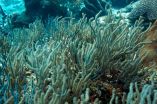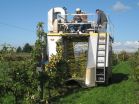(Press-News.org) When cancer is diagnosed, the grade of its malignancy is a central concern for both patients and their physicians. This value is used to determine how intensively and how radically the cancer must be treated. Particularly in the case of prostate cancer, the disease can take widely varying courses in different patients. Therefore, cancer researchers have been looking for measurable, reliable biomarkers that give clues about the aggressiveness of a tumor in order to choose an appropriate therapy.
In many types of cancer, alterations in a tumor's genetic material indicate how dangerous the cancer is. Prostate cancer, however, exhibits far fewer of these mutations than other cancer types. "We have therefore suspected that prostate cancer is driven primarily by alterations in epigenetic characteristics, that is, chemical changes in the genetic material that do not affect the sequence of DNA building blocks," says Prof. Christoph Plass from the German Cancer Research Center (Deutsches Krebsforschungszentrum, DKFZ), who is one of the project leaders in the current publication.
For a long time, the means by which epigenetic patterns in the DNA of cancer cells undergo changes have remained a mystery. Scientists have discovered specific cellular proteins that can have a major influence on such patterns. A network of researchers from the German Cancer Research Center (DKFZ), the University of Zurich, Hamburg-Eppendorf University Hospital, Heidelberg University, and other institutes have been searching for regulatory proteins that change the epigenetic characteristics of prostate cancer cells and may thus have an impact on the course of the disease.
In a first step, the scientists searched databases containing molecular information on a large number of prostate cancer cases. Using these data, they investigated whether a particular, known epigenetic regulatory protein is expressed in tumor cells at significantly higher or lower levels than in healthy cells from the same patient.
The researchers found the most obvious differences in the expression of a protein called BAZ2A. "The normal known function of this protein is to suppress factories that produce cellular proteins and thus affect the viability of cells," says Prof. Roland Eils, who leads a research group at both the DKFZ and at Heidelberg University. "But when we turned off BAZ2A in the cell lines of metastasizing prostate cancer, their growth was paradoxically slowed." Further studies showed that higher levels of BAZ2A increased specific malignant properties of prostate cancer cells, including their mobility and capacity to invade surrounding tissue.
A detailed molecular analysis of prostate cancer cells showed that the overproduction of BAZ2A led to alterations in epigenetic patterns which then inhibited the activity of a number of cancer-suppressing genes.
The scientists therefore suspected that the overexpression of BAZ2A might have a direct impact on the malignancy of prostate cancer and thus serve as a predictor for the course of the disease.
The team investigated this hypothesis using nearly 7,700 tissue samples obtained from prostate cancer patients. They discovered that the higher the BAZ2A levels in the tissue were, the more advanced the tumor was at the time of diagnosis, the more frequently it had already spread and formed metastases, and the higher patients' PSA levels were.
"BAZ2A seems to have a direct influence on the aggressiveness of prostate cancer," Plass says. "This suggests that levels of BAZ2A expression may serve as a valuable predictor of disease progression. Of course, this still needs to be clinically confirmed. Particularly in patients whose other clinical results indicate a medium risk, BAZ2A expression may provide important clues for the actual chances of recurrence. This would help physicians and patients choose the most promising treatment.
INFORMATION:
The study is part of the International Cancer Genome Consortium (ICGC). Collaborators in the project "Early Onset Prostate Cancer" are the Martini-Klinik and Hamburg-Eppendorf University Hospital, EMBL, DKFZ, the National Center for Tumor Diseases (NCT) Heidelberg, and the Max Planck Institute for Molecular Genetics in Berlin. The project coordinators are Prof. Christoph Plass from the DKFZ and Prof. Guido Sauter from Hamburg-Eppendorf University Hospital. The Federal Ministry of Education and Research (BMBF) has provided funds of €7.5 million for the project.
MIAMI - A new study on tropical shallow-water soft corals, known as gorgonians, found that the species were able to calcify and grow under elevated carbon dioxide concentrations. These results suggest that Caribbean gorgonian corals may be more resilient to the ocean acidification levels projected by the end of the 21st century than previously thought.
An international team of scientists, including from the University of Miami (UM) Rosenstiel School of Marine and Atmospheric Science, tested the effects of elevated CO2 concentrations on the growth and calcification rates ...
Study results of CD19-directed chimeric antigen receptor (CAR) therapy using the Sleeping Beauty non-viral transduction system to modify T cells has demonstrated further promise in patients with advanced hematologic malignancies.
Patients who had acute lymphocytic leukemia (ALL), non-Hodgkin lymphoma (NHL) or chronic lymphocytic leukemia (CLL) were part of clinical trials at The University of Texas MD Anderson Cancer Center, which used the Sleeping Beauty gene transfer system initially discovered at the University of Minnesota.
Results from the study were presented ...
Low doses of fluoxetine - better known as the anti-depressant Prozac - could hold the key to preventing PMS symptoms, an international team of researchers has found.
Up to 80 per cent of women are thought to suffer from premenstrual syndrome (PMS), which can be a debilitating condition with symptoms such as anxiety, irritability, fatigue, sleep deprivation and increased sensitivity to pain.
PMS appears to be triggered by the fall in secretion of the ovarian sex steroid hormone progesterone that occurs towards the end of the menstrual cycle and leads to a decline in ...
In 2012 the Mars Science Laboratory landed in the fascinating Gale crater. The Gale crater is of such great interest because of the 5.5 km high mountain of layered materials in the middle. This material tells an intricate story of the history of Mars, perhaps spanning much of the existence of this mysterious planet.
Once positioned, the Curiosity rover began field studies on its drive toward Aeolis Mons (also unofficially known as Mount Sharp), the central peak within the crater. Curiosity has travelled more than 9.4 km so far and during its trip up the mountain, Curiosity ...
A new advance in biomedical research at the University of Leicester could have potential in the future to assist with tackling diseases and conditions associated with ageing - as well as in treating cancer.
The research, which has shown promise in clinical samples, has been published in the prestigious scientific journal, Cell Death and Disease.
The group of scientists coordinated by Dr Salvador Macip from the Mechanisms of Cancer and Ageing Lab and the Department of Biochemistry of the University of Leicester carried out the study to find new ways of identifying old ...
Insects are full of marvels - and this is certainly the case with a beetle from the Tenebrionind family, found in the extreme conditions of the Namib desert. Now, a team of scientists has demonstrated that such insects can collect dew on their backs - and not just fog as previously thought. This is made possible by the wax nanostructure on the surface of the beetle's elytra. These findings by José Guadarrama-Cetina, then working at ESPCI ParisTech, France - on leave from the University of Navarra, in Spain - and colleagues were recently published in EPJ E. They bring ...
MOUNT VERNON, WA - Cider - or "hard cider" as it is typically known in the United States - is experiencing a real revival. The fermented apple juice with 0.5% to 7% alcohol-by-volume is the fastest growing alcohol market segment in the US, boasting a 54% increase in production annually from 2007 to 2012. Naturally, increasing consumer demand for cider translates to a need for more apples to make quality cider products.
Carol A. Miles and Jaqueline King from Washington State University's Department of Horticulture published a study in HortTechnology that can provide apple ...
An article published in the Health Affairs December issue is the first ever comprehensive analysis to investigate the Affordable Care Act's (ACA) Essential Health Benefit (EHB) as it relates to children. The study found that the EHB has resulted in a state-by-state patchwork of coverage for children and adolescents that has significant exclusions, particularly for children with developmental disabilities and other special health care needs.
Previous studies have compared the EHB standard more broadly to the Children's Health Insurance Program (CHIP), but this analysis ...
WEST LAFAYETTE, IN/ITHACA, NY - Energy costs account for one of the largest expenses in commercial greenhouse production of annual bedding plants. Naturally, bedding plant producers are searching for more energy-efficient production methods that can reduce fuel usage and increase profits. Christopher Currey, Roberto Lopez, and Neil Mattson published a study in HortTechnology that gives growers in northern latitudes valuable information on finishing practices for annual bedding plants. The researchers compared traditional heated greenhouses with unheated high tunnels for ...
(SAN FRANCISCO, December 6, 2014) - New treatment combinations and targeted therapies for lymphoma and multiple myeloma are improving outcomes for vulnerable patient populations with hard-to-treat disease, according to studies presented today at the 56th American Society of Hematology (ASH) Annual Meeting and Exposition.
Despite advances in lymphoma treatments, improving the prognosis for patients with relapsed and treatment-resistant disease remains a challenge. The early success of several precision therapies associated with fewer side effects than conventional approaches ...





